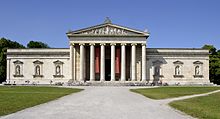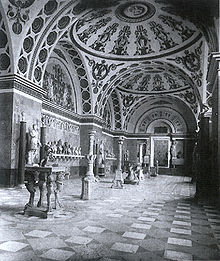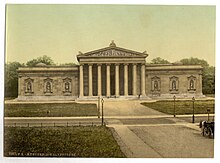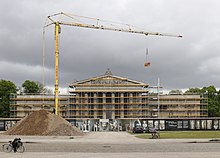Glyptothek (Munich)
|
Glyptothek on Munich's Königsplatz |
|
| Data | |
|---|---|
| place | Munich |
| Art |
Ancient sculpture collection
|
| architect | Leo von Klenze |
| opening | 1830 |
| operator | |
| management | |
| Website | |
| ISIL | DE-MUS-097514 |

The Glyptothek ( ) in the Kunstareal Munich is a museum for the collection of ancient sculptures established under Ludwig I and was built from 1816 to 1830 according to plans by Leo von Klenze on Königsplatz in Munich .
Only a part of the collection comes from the old possession of the Wittelsbach family , a large part goes back to the collecting activity of Ludwig I. The main works of the collection are above all the Barberin Faun , the so-called Trunkene Alte , the boy with the goose, the Eirene with the Ploutos boy and the valuable gable figures acquired in 1813 from the Aphaia Temple in Aegina , the so-called Aeginetes and the two Kouroi , the Munich residents Kouros and the Kouros of Tenea.
The counterpart to the Glyptotek, the former as ancient Museum cabaret designated State Collection of Antiquities . They are located on the south side of the Königsplatz across from the Glyptothek and house antique objects and art objects in the form of clay vessels, statuettes made of clay and bronze, gold jewelry, glass, gems, etc.
The building
Building history
The building was erected on Königsplatz on behalf of Crown Prince Ludwig, who later became King Ludwig I. The architect Leo von Klenze created this square from 1815 based on previous designs by Karl von Fischer in the style of an ancient forum , with the Glyptothek on the north side. The building was built between 1816 and 1830 according to plans by Leo von Klenze.
After the partial destruction in the air raids on Munich in the Second World War , reconstruction began in 1947 and reopened in 1972. The reconstruction was largely carried out by the later museum director Dieter Ohly (management 1962–1978). The important frescoes The Gods of Greece , executed by Peter Cornelius from 1820 to 1830 , were destroyed in the Second World War and not restored. Only a few fragments have survived, and the National Gallery in Berlin owns the boxes . The Assyrian Hall, built by Klenze in the inner courtyard in 1864, was also not restored after the war; the eight Assyrian reliefs and the Babylonian lion are now in the Egyptian State Collection . The large column set up in the inner courtyard comes from the earlier vestibule of the opposite, modernly rebuilt building of the antique collections .
A comprehensive general renovation has been carried out since October 2018. The reopening is planned for October 2020.
Building description
The thirteen rectangular, square or round halls are arranged around an inner courtyard, while the vestibule in the central building rises above the halls. In front of the vestibule is the portico with twelve Ionic columns . The overlying group of gables by Johann Martin von Wagner depicts Athena as the protector of the plastic arts. The outer walls are decorated with sculptures located in niches, while the windows open to the inner courtyard. The sculptures depict mythical or historical representatives of the arts, on the front facing Königsplatz there are Daedalus , Prometheus , Hadrian , Pericles , Phidias and Hephaestus . On the western and eastern sides of the building there are sculptors from the Renaissance and the time the Glyptothek was built (including Bertel Thorvaldsen and Antonio Canova ), whose works were previously exhibited in the Newer Room and later moved to the Neue Pinakothek .
The management of the Glyptothek is located in the house of the cultural institutes . Archaeologist Florian Knauß has been the director of the Munich Glyptothek since 2011 .
The collection
Collection history
The Glyptothek has sculptures, mosaics and reliefs from the archaic period (approx. 650 BC) to the late Roman period (approx. 550 AD). Some of the sculptures had been in the possession of the Wittelsbach family for a long time, for example the drunken old woman was a gift to Elector Johann Wilhelm von der Pfalz . However, the collection goes back primarily to King Ludwig I, who began to systematically acquire ancient sculptures as Crown Prince in 1804. His father had little understanding for this. "My crazy son wants to spend money again, I'm sure of it, to buy old junk, and he hopes to turn this race of beer drinkers into Greeks and Romans," said Max I Joseph , characterizing the heir apparent's hobby in a letter . Ludwig's art agent Johann Martin von Wagner acquired the Barberin Faun in Rome in 1813 and in the same year in Greece the gable figures of the Aphaia Temple in Aegina, the so-called Aeginetes . Leo von Klenze bought the portraits of the goddess Eirene and Diomedes in Paris in 1815/16 , while Ilioneus, from the collection of Emperor Rudolf II in Prague, was acquired by Ludwig himself in Vienna in 1814. A statue that presumably represents the blacksmith god Hephaestus is the so-called Munich King , which Ludwig I acquired in Paris in 1815 from the Albani collection. Further acquisitions were made in later times, for example, in 1853 the Apollo von Tenea and in 1909 the so-called Munich Kouros came to the Glyptothek. The equally famous discus thrower from Esquilin (Myron's discus thrower), bought in 1938, had to be returned to Italy ten years later under pressure from the American occupation forces.

Archaic Period (700-490 BC)
Main works of archaic art are in particular the early Greek youth statues ( Kouroi ), including the Munich Kouros (youth from Attica, approx. 540 BC) and Apollo von Tenea (Kouros from Tenea near Corinth, approx. 560 BC) and the Aeginetes (gable figures of the Aphaia temple of Aegina, approx. 500-480 BC).
Classical period (490–323 BC)
Among the best-known works of the Greek classical period are: the portrait of Homer (460 BC), the Munich king (460 BC), the statue of Diomedes (430 BC), the Medusa Rondanini ( 440 BC), the grave stele of Mnesarete (380 BC), the statue of Eirene (370 BC), Alexander Rondanini (approx. 338 BC) and the kneeling youth Ilioneus (approx . 320 BC).
Hellenistic period (323–146 BC)
The best-known work of Hellenism is the Barberin Faun (220 BC). Other Roman copies of famous Greek sculptures from this period include the boy with the goose (approx. 250 BC) and the drunken old woman (approx. 200 BC).
Roman sculptures (150 BC - 550 AD)
The bronze head of a youth (around the birth of Christ) is also a Roman imitation in the classical style . The Glyptothek has a rich collection of Roman portraits, including the famous sculptures depicting Marius and Sulla (approx. 40 BC) as well as numerous portraits of emperors, including Augustus (approx. 40 AD), Nero (65 AD) .), Septimius Severus (200 AD) and his wife Julia Domna (195 AD). A statue with a sword belt heroizes Domitian as a prince (around 75 AD). With the support of the Kulturstiftung der Länder , in 2017 the Glyptothek was able to acquire a head of Caligula from the Spanish art trade that was excavated in Córdoba in 1937 and made during his lifetime . Like the Munich portrait of his ancestor Augustus ( Augustus Bevilacqua ), the emperor wears the corona civica . One of the attractions is the "Apollon Barberini", a colossal statue of Apollon as a kitharoden (1st / 2nd century AD).
Antiquity in the art area
The holdings of the Glyptothek are supplemented by the antique vase art, bronzes and gold jewelry in the antique collections , which are run as a museum with the Glyptothek. Greco-Roman sculptures that have been made in Egypt since the Hellenistic conquest can be found in the State Museum of Egyptian Art . There is a separate collection on the east side of the Königsplatz for the casts of ancient sculptures from other museums around the world .
Major exhibitions (selection)
- 1999 Greeks among Greeks , exhibition about Joannis Avramidis
- 2003/04 Colorful Gods - The colorful world of the ancient Greeks
Directors
- Heinrich Brunn (1865-1894)
- Adolf Furtwängler (1894–1907)
- Paul Wolters (1908-1935)
- Carl Weickert (1934–1936)
- Hans Diepolder (1937–1962)
- Dieter Ohly (1962–1978)
- Klaus Vierneisel (1978–1994)
- Raimund Wünsche (1994-2011)
- Florian Knauß (since 2011)
reception
The Ny Carlsberg Glyptotek in Copenhagen was named after the Munich Glyptothek.
literature
- Alice Klose: The reconstruction of the Neues Museum in Berlin as a staging of its own history. The change in handling fragments compared to the Glyptothek in Munich. Dissertation Munich 2015 ( University Library LMU Munich ).
- Adrian von Buttlar and Bénédicte Savoy: Glyptothek and Alte Pinakothek, Munich. Museums as Public Monuments. In: Carole Paul (ed.). The First Modern Museums of Art. The Birth of an Institution in 18th- and Early-19th-Century Europe. The J. Paul Getty Museum, Los Angeles, CA 2012, ISBN 978-1-60606-120-6 , pp. 304-329.
- Carole Paul (Ed.): The First Modern Museums of Art. The Birth of an Institution in 18th- and Early-19th-Century Europe. The J. Paul Getty Museum, Los Angeles, CA 2012, ISBN 978-1-60606-120-6 .
- Raimund Wünsche : Glyptothek Munich. Masterpieces of Greek and Roman sculpture. Beck, Munich 2005, ISBN 3-406-42288-8 .
- Leon Krempel and Anthea Niklaus (eds.): Cornelius, Prometheus, the thought leader. Contributions to the symposium. At the opening of the exhibition: The Gods of Greece. Peter Cornelius (1783-1867). The cardboard boxes for the frescoes in the Glyptothek in Munich . Munich 2004.
- Thorsten Marr: The Munich Glypthothek and the Dresden Albertinum. To convey and appreciate museum equipment in the 19th century. In: Leon Krempel and Anthea Niklaus (eds.). Cornelius, Prometheus, the thought leader. Contributions to the symposium. At the opening of the exhibition: The Gods of Greece. Peter Cornelius (1783-1867). The cardboard boxes for the frescoes in the Glyptothek in Munich . Munich 2004, pp. 84–97.
- Franziska Dunkel: “No one who would be worthy of the award”? For the expert opinion on the architectural competition for Invalidenhaus, Walhalla and Glyptothek. In: Münchner Jahrbuch der bildenden Kunst 53, 2002, pp. 253–281.
- Hugo Meyer : The fictitious Glyptothek. The way of the late Enlightenment expert David Friedrich Strauss into the Munich emigration. Edited by Michaela Fuchs . Phoibos, Vienna 2019, ISBN 978-3-85161-205-9 .
Web links
- Museum website
- Glyptothek on the website of the Bavarian State Ministry for Education and Culture Science and Art
- Description of the Glyptothek with 3D reconstruction
- Boy with the goose - 3D model of the sculpture in the culture portal bavarikon
Individual evidence
- ^ History. In: www.antike-am-koenigsplatz.mwn.de. Retrieved November 24, 2015 .
- ↑ Abendzeitung Germany: Munich: Glyptothek on Königsplatz closed for two years. Retrieved April 29, 2019 .
- ↑ Bowing to antiquity. Retrieved August 5, 2017 .
- ↑ Glyptothek exhibition. Retrieved July 24, 2017 .
- ↑ The last emperor. Retrieved July 25, 2017 .
Coordinates: 48 ° 8 ′ 46.7 ″ N , 11 ° 33 ′ 56.3 ″ E




